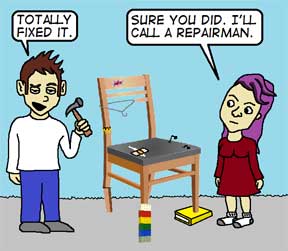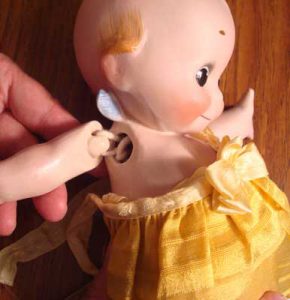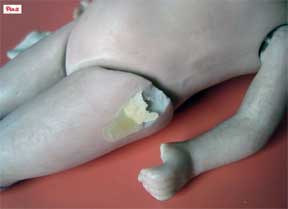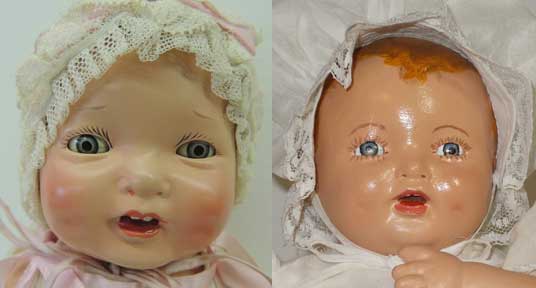Professional Doll Restoration or Doll Repair?
So, what is the difference? The dictionary says:
* to repair is to mend or make usable
* to restore is to bring back to an original condition
If you are going to bring a broken, dilapidated doll back to its original condition, you must be a skilled doll restoration artist.
 Whether you are doing a complete doll restoration, or a simple repair, you must be skilled and knowledgeable about the materials used in that particular doll. If not, you risk devaluing your doll. Think of the quality of work between a regular handyman and a skilled, certified repairman. They can both get the job done, but often the results are vastly different.
Whether you are doing a complete doll restoration, or a simple repair, you must be skilled and knowledgeable about the materials used in that particular doll. If not, you risk devaluing your doll. Think of the quality of work between a regular handyman and a skilled, certified repairman. They can both get the job done, but often the results are vastly different.
Below is a picture showing a doll patched together on the left. You can still see the glue and no effort was made to fill the crack or match the paint. On the right, a 10” bisque kewpie had a missing piece from her shoulder and the loop on the arm was also missing. I filled in the hole on her shoulder and rebuilt the stringing loop. I then matched the color and airbrushed her repaired areas. It is not possible to bring a broken porcelain doll back to original condition, because it cannot be kiln fired like it was originally, but by appearances she now looks like she did originally. Doll restoration should be nearly undetectable either on the shelf, or up close.
Problems with home doll repairs:
- common household adhesives are inappropriate
- some are too thick or discolor
- others bond almost instantantly, giving one brief moment to get it right
- all these products are hard to remove and will make any future repair work much more difficult and time consuming
It takes years of studying both antique dolls and restoration methods. The restoration materials available today are not the same as they were 40 years ago. I spend a lot of time studying reference books about antique and vintage dolls. I also spend time researching best practices in doll restoration and the availability of museum quality materials. Doll restoration artists often use specialist adhesives that are not readily available to the public.
Antique Effanbee Bubbles
The picture on the left is an unrestored Effanbee Bubbles doll and the doll on the right is a poorly repaired Effanbee Bubbles doll. A doll that has been professionally restored will look almost identical to the original doll, including blush, lashes, brows, lips and sheen.
Unrestored Doll
- smooth skin surface with a slight sheen
- Lashes and brows are correctly placed and evenly spaced
- Blush and hair have been airbrushed
Doll Repaired by an amateur
- skin surface is bumpy and very shiny
- lashes and brows are incorrectly placed and are uneven
- Brush strokes can be seen
Doll Restoration vs Doll Repair
Sometimes all a doll needs is a simple professional doll repair to make it look great again. If you attempt those repairs yourself, you must be very certain you understand the material you are working with and don’t do more harm than good to your doll.
 One example is cleaning. Most people don’t realize how dirty their treasured doll is. A doll or teddy that is 50 – 100 years old has decades of dirt and dust that you often don’t see until you wash it off. Once you remove the dirt, grime, and smudges of all those years of love and play, it makes an amazing difference. I have had customers who do not recognize their doll when all that was done to is was an extensive cleaning. Don’t attempt a cleaning without a thorough understanding of the material your doll is made from. Water cannot be used on everything and some solvents will clean one doll, but melt a different one.
One example is cleaning. Most people don’t realize how dirty their treasured doll is. A doll or teddy that is 50 – 100 years old has decades of dirt and dust that you often don’t see until you wash it off. Once you remove the dirt, grime, and smudges of all those years of love and play, it makes an amazing difference. I have had customers who do not recognize their doll when all that was done to is was an extensive cleaning. Don’t attempt a cleaning without a thorough understanding of the material your doll is made from. Water cannot be used on everything and some solvents will clean one doll, but melt a different one.
Another repair would be to clean, restore, and style a doll wig, but it can take as much as four hours of work to make an old doll wig look great again. Even the most tangled, thin old wig can be made to look wonderful. Thin wigs can sometimes have locks of the same kind of hair added to make them fuller. Frizzy, wild hair can be tamed and restyled. An old doll with a good original wig has more value than a doll with a replaced wig. Sometimes though, a doll simply has to have a new wig.
Another repair would be to replace a doll’s stringing. When the elastic becomes old, the rubber deteriorates, the doll becomes loose, or the limbs fall off. Then the stringing must be replaced so the doll can stand up straight again without sagging. The doll elastic is not the kind that is used for sewing, but a round cord that comes in different sizes. Except in smaller dolls, the elastic should not be tied off, but be clamped with a hog ring, just like the original.
Sometimes it is hard to say whether a dolly operation is a repair or a restoration. Either way, the goal should still be to bring the doll closer to its original condition. If a doll is missing fingers or toes, they can be rebuilt and you may never know that the finger was ever missing, even by looking closely. Just patching would be a doll repair. Bringing the hand or foot back to its original condition would be a doll restoration. This site shows good examples of doll restoration. http://www.joannmorgan.com/seminars/10-learn-doll-repair-and-restoration-a-lifetime-career.html



